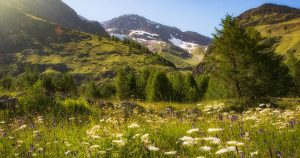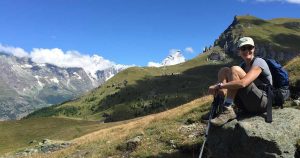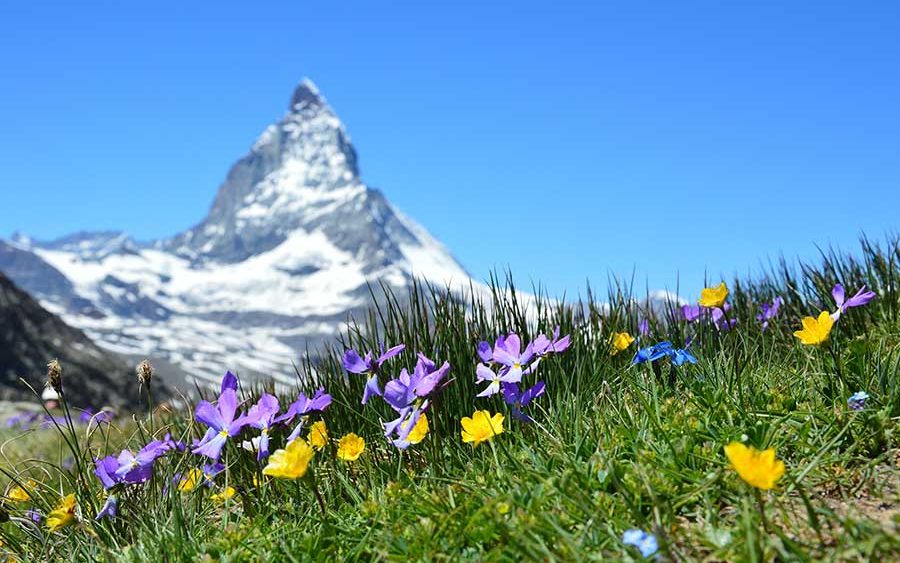The Italian-Swiss Alps are the heart of what Ryder Walker does. Trek beneath the glittering glaciers of the highest peaks in Western Europe! Stay in classic huts and hotels, and visit the historic centers of European mountaineering. This represents the best of European Trekking.
Iconic Mountains
The iconic mountains of this region are the Monte Rosa – which rests above Zermatt, Saas-Fee, and the Italian Cervinia, and the Matterhorn. The Matterhorn is famous for its iconic profile, and the distant but visible giants of the French Savoie. Ryder Walker’s Matterhorn Trek provides stunning views of these legendary mountains.
Notable Villages
It takes you through what we think are some of the most charming resorts and villages of the Italian-Swiss Alps.
Cervinia
The trek begins in Cervinia, winding its way through the mountains to finish in the Swiss town of Zermatt. Zermatt sits beneath the looming North face of the Matterhorn.
The start of our trek, Cervinia, sits beneath the Italian face of the Matterhorn, or as it is known in Italian, Cervino. From this angle, the Matterhorn looks like a far less intimidating mountain. The first expeditions to the summit were launched from this direction. Eventually, it was determined that the Swiss route was actually less perilous. The Swiss mountaineers based out of Zermatt won the heated race to the summit.
Macugnaga
From Cervino we travel through the Pennine Alps towards Macugnaga. In Macugnaga we will stay beneath the towering east face of the Monte Rosa. Monte Rosa is the second highest peak in Western Europe.
Saas-Fee
From Macugnaga we trek into Switzerland, into the charming village of  Saas-Fee which rests high above the valley. Saas Fee is a location with a remarkable amount of comfort and culture. It features many fine hotels, restaurants, as well as world famous skiing in the winters. Finally, we travel in the direction of Zermatt, perhaps the most well-known mountain town in the world.
Saas-Fee which rests high above the valley. Saas Fee is a location with a remarkable amount of comfort and culture. It features many fine hotels, restaurants, as well as world famous skiing in the winters. Finally, we travel in the direction of Zermatt, perhaps the most well-known mountain town in the world.
Zermatt
Zermatt has been entirely closed to cars and has multiple historic sections of the town. These exemplify the old Swiss stadl style of architecture. This is trademarked by massive beams of aged wood, elevated farmer’s homes, and old cobblestone streets. This glorious finish to the trip also allows for the most classic view of the Matterhorn if the weather is fair.
History
The Italian-Swiss Alps’ history is a relatively simple one, with the original inhabitants being shepherds and farmers. They traveled up from the Rhone valley in search of the high alpine pasture land that would later become a staple of the Swiss identity. The region finally boomed when the Victorian English traveled into these villages with the intention of climbing the highest peaks in Europe.
This created a flashpoint for national competition with Italy, France, and Switzerland all vying to have their guides be the first to stand on top of Europe. This time period led to some classic mountaineering stories. One classic legend is that the Swiss mountaineers who first ascended the Matterhorn threw rocks down on the ascending Italian climbers to prove that they had reached the summit first.
This same expedition, led by Edward Whymper, ended in a tragic disaster when the brave climbers all disappeared after the failure of a climbing rope. The rope itself has been recovered and can be viewed in the Zermatt Matterhorn Museum, which is a must-see destination if you are interested in mountaineering history.
Cuisine
The food in the Pennine Alps is classic alpine food. Hearty and delicious, these dishes still reflect the original foods eaten by the agricultural inhabitants of the Italian-Swiss Alps. They consist largely of potatoes, cheeses, and meats.
Get ready for a lot of incredible cheese, as each individual valley has their own personal cheeses. The cheeses vary in every way from texture to flavor. All share the incredible quality of small local production. Some exemplary dishes include rosti, a shredded potato and cheese dish that could be considered the world’s best hash browns, fondue, crepes, and varied risottos – often cooked with ham or saffron.
Hiking the Italian-Swiss Alps

Hiking in the Italian-Swiss Alps is rugged but well maintained. The mountains here are glorious and are truly giants. Although we don’t approach any of the great peak’s summits, even the passes separating the villages rise thousands of feet above the valley floor.
Despite the effort of the hiking and its occasional exposure, the trails all carry the mark of the excellent Swiss and Italian mountain clubs. These clubs keep the trails exceptionally well-marked and maintained. The region has many highlights and represents some of the best trekking in Europe.
Hiking Highlights
Some of the hiking highlights include looking down on the village of Alagna, over 6,000 feet below the Col d’Olen. Another is ascending the Turlo Pass, which follows an ancient Roman road and is still littered with the remnants of conflict from the first World War. The hiking here is a challenge, but it is a rewarding challenge. As a result, the Italian-Swiss Alps is the best place to hike for experienced and passionate hikers.









Comments are closed.